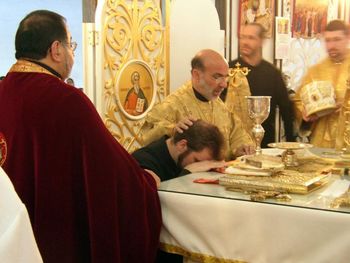Hirotonie
| Acest articol (sau părți din el) este propus spre traducere din limba engleză!
Dacă doriți să vă asumați acestă traducere (parțial sau integral), anunțați acest lucru pe pagina de discuții a articolului. |

| Acest articol face parte din seria Spiritualitate ortodoxă | |
| Sfintele Taine | |
| Botezul – Mirungerea Sf. Împărtășanie – Spovedania Căsătoria – Preoția Sf. Maslu | |
| Starea omului | |
| Păcatul – Patima – Virtutea Raiul – Iadul | |
| Păcate | |
| Păcate strigătoare la cer | |
| Păcate capitale | |
| Alte păcate | |
| Păcatele limbii | |
| Virtuți | |
| Virtuțile teologice | |
| Virtuțile morale Înțelepciunea – Smerenia | |
| Etapele vieții duhovnicești | |
| Despătimirea (Curățirea) Contemplația Îndumnezeirea | |
| Isihasm | |
| Trezvia – Pocăința Isihia – Discernământul Mintea | |
| Asceza | |
| Fecioria – Ascultarea Statornicia – Postul Sărăcia – Monahismul | |
| Rugăciunea | |
| Închinarea – Cinstirea Pravila de rugăciune Rugăciunea lui Iisus Sf. Moaște – Semnul Sf. Cruci | |
| Sfinții Părinți | |
| Părinții apostolici Părinții pustiei Părinții capadocieni Filocalia Scara dumnezeiescului urcuș | |
| Editați această casetă | |
Ordination is the sacrament (or Holy Mystery) of holy orders. The Greek words used for ordination are cheirotonia and cheirothesia, both of which mean "the laying on of hands." Members of the major orders of the cler—episcop, preot, şi diacon—are ordained during the Sfânta Liturghie by the bishop, who is usually assisted by several priests. According to Orthodox teaching, the process of ordination begins with the local congregation; but the bishop alone, who acts in the name of the universal Church, can complete the action.
Those who are placed into the minor orders (subdeacon, anagnost, and in some traditions, cantor) are done so by cheirothesia, which also means "laying on of hands," but has come to be a technically distinct term from cheirotonia, which is used only for the major orders. According to the DEC, cheirothesia is not regarded as part of the Holy Mystery of ordination (p. 117).
Cheirotonia and cheirothesia formerly were used almost interchangeably, but came to acquire distinct meanings. Bishops are also referred to as being "consecrated" rather than "ordained," but such a distinction was not present in the early Church (ODCC, p. 1189)
Cuprins
Minor orders
Cantor
Anagnost
In preparation for the tonsuring, the candidate shall have a cassock by the day of the tonsuring. On the eve of his tonsuring, the candidate shall attend Vespers, and, after having a light supper, begin his Eucharistic fast. During that time, he shall interact as little as possible with anyone and spend that time praying and preparing himself for the tonsuring. Married candidates shall refrain from marital relations during this time. He shall have his confession heard either after Vespers or during Orthros on the day of the tonsuring.
On the day of the tonsuring, following the Great Doxology, but before the troparion before the Divine Liturgy, the candidate is led by the bishop's assistant to the center of the solea in front of the bishop. He makes three (3) prostrations toward the holy altar. Then, he turns and makes one (1) prostration toward the bishop and stops on his knees. The Bishop lays his hand on the candidate head.
Subdiaconate
Subdeacons are ordained during the Divine Liturgy immediately before "Blessed is the Kingdom", once the Great Censing has been completed. According to the canons, no one should marry after becoming a subdeacon, but the practice has almost universally changed to allow subdeacons to marry after being made subdeacons.
Major orders
Diacon
Preot
During the service of ordination to the priesthood, a priest leads the candidate, who then kneels and rests his head on the altar. The bishop puts his stole and right hand over the candidate's head as the candidate receives the Duhul Sfânt. The entire congregation witnesses the ordination and proclaims the work of the Holy Spirit by shouting in unison "Axios!" (Greek word meaning 'worthy'). The bishop bestows sacred veşminte on the new priest, who receives communion and recites a special prayer. Through ordination, men who have been chosen from within the Church are set apart by the Church for special service to the Church. Much of the time, a candidate for ordination will pursue preparatory studies at a seminary.
Episcop
Candidates for the episcopacy are consecrated by three bishops (or at the very least two) to be bishops. A bishop's non-liturgical veşminte include the kamilavka and epanokameloukion (veil) (which are joined together as the klobuk in the Russian tradition), along with the mantiya, all of which are monastic garments.
See also
References
- Blackwell Dictionary of Eastern Christianity (DEC), p. 117
- Oxford Dictionary of the Christian Church (ODCC), 3rd ed., pp. 1188-89